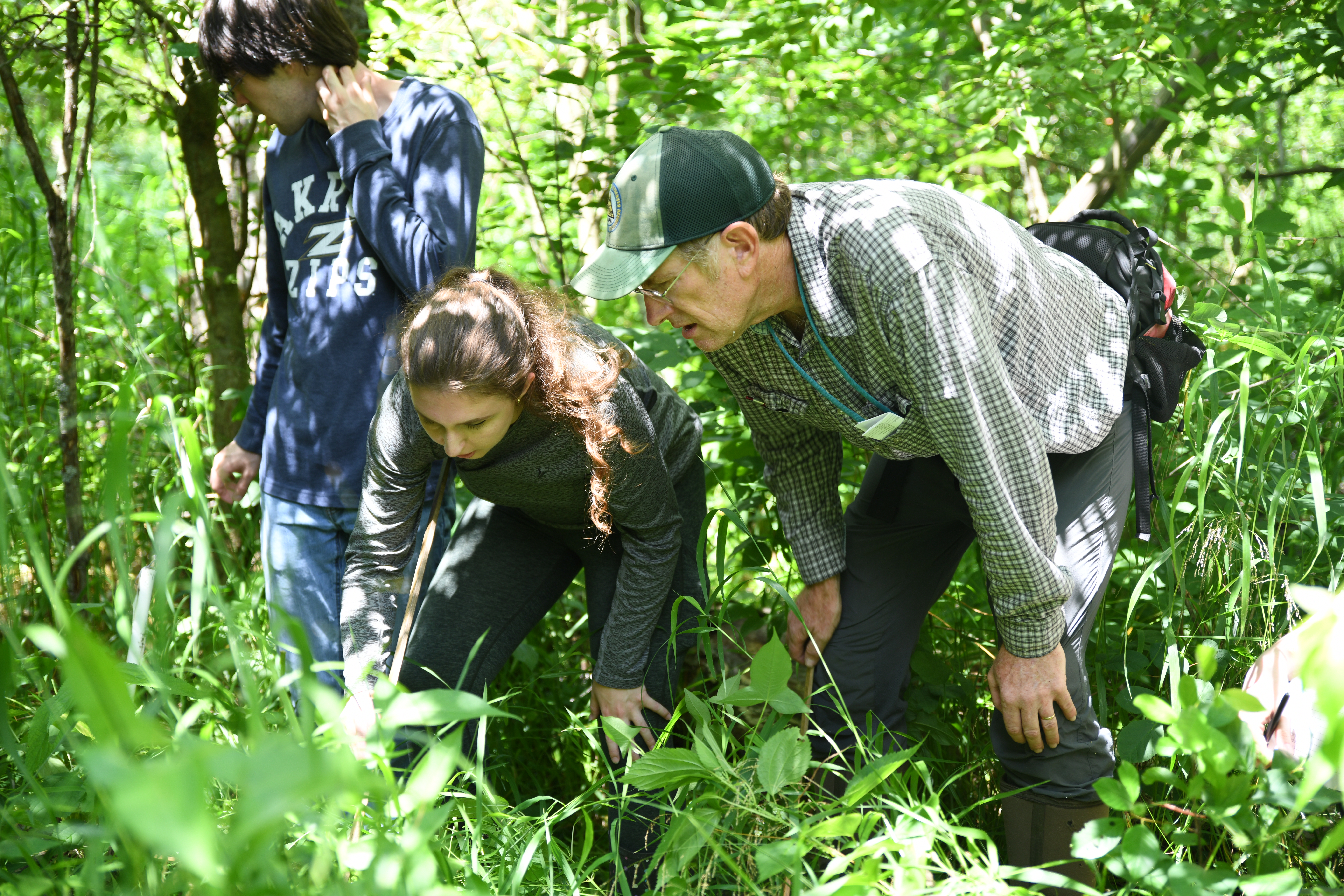Faculty tend to specialize in focused research areas, and it becomes their life’s work. For Dr. Randy Mitchell, professor of biology at The University of Akron (UA), his interest lies in the work of plant pollinators, such as bees. His work is so significant that he has been ranked among the top 2% of scientists in the world, in his field of expertise.
Conflict of interest is what drives his research. Looking into evolutionary biology, he has sought to understand the essential elements that make up evolution, specifically how pollinators affect one another.
Flowers have evolved mechanisms that make sure a pollinator is effective at moving pollen, while bees have attributes that help them get the most food with as little effort as possible. This conflict of interest between plants and pollinators is what sparked his interest in bee pollination and the reciprocal impact the have on each other.
.jpg)
Dr. Mitchell and students at the UA Field Station in Bath Township.
Part of his work is completed at the Dr. Paul E. Martin Center for Field Studies and Environmental UA Field Station in Bath Township, where he actively gets students involved with his research.
“Students are a vital part of all my research. At the Tamarack Bog restoration at the Field Station, they mostly help to identify and evaluate the plants. By the end of each season, the students go from knowing nearly no plants to being able to identify several dozen, and are able to distinguish perhaps 100 species,” said Mitchell. “Many of these students have gone on to careers in environmental restoration, monitoring and consulting, in part based on the skills and experiences gained in this restoration project.”
Few UA faculty study ecological interactions outdoors, so Mitchell is all too happy to offer this unique, hands-on approach to students who have an interest in the outdoors, animals and plants.
“This is where the real learning happens. A lot of my research has changed because I have had a surplus of interest [from students] in restoration of wetlands. This has helped to better serve our students,” said Mitchell.
Mitchell has three recent research activities worth noting. Firstly, he is in the tenth and final year of evaluating ecological restoration at the UA Field Station, collaborating with Bath Township to recover the area.
This wetland was damaged (drained) in the 1960s, which harmed the native vegetation. Furthermore, the drier environment allowed plants that don’t belong there to get established, degrading the habitat for wildlife. Around 2012, Bath Township, which owns and manages the wetland, started work with UA to restore the bog. Shortly after that,
“This is where the real learning happens. A lot of my research has changed because I have had a surplus of interest [from students] in restoration of wetlands. This has helped to better serve our students,” said Mitchell.
Mitchell has three recent research activities worth noting. Firstly, he is in the tenth and final year of evaluating ecological restoration at the UA Field Station, collaborating with Bath Township to recover the area. This wetland was damaged (drained) in the 1960s, which harmed the native vegetation. Furthermore, the drier environment allowed plants that don’t belong there to get established, degrading the habitat for wildlife. Around 2012, Bath Township, which owns and manages the wetland, started work with UA to restore the bog. Shortly after that, the Ohio EPA suggested toa developer that providing monetary support for that restoration work would fulfill a mitigation agreement (meaning that if a developer destroys a wetland, they need to either make new wetlands or protect/improve/restore others). That mitigation agreement pays for the restoration activities, and also for monitoring at the Tamarack Bog. Each year, Mitchell and his students at UA do the monitoring, which is a detailed survey of the wetland to evaluate whether the restoration goals are being met.
Secondly, Mitchell recently completed research, funded by a grant from the National Science Foundation, focused on looking into how plants and pollinators affect one another. The research analyzed how much self-pollination happens under different circumstances and how the diversity of mates that plants interact with changes in the environment.
Thirdly, Mitchell and a team of researchers embarked on a survey of various sites in Ohio to find the Rusty Patch Bumblebee. In 1995, it was the most common bee you would see in Ohio, but by 2000 it was rarely seen. The last time it was spotted in Ohio was in 2013 and, during the past 10 years, it has continued to be unnoted. In 2017, Mitchell and a team of researchers started traveling around the state surveying various sites and looked at more than 25,000 bumblebees, and not one was the Rusty Patch Bumblebee. The species still exists in Wisconsin, Minnesota and Iowa, but its disappearance from Ohio highlights the significance of understanding and preserving pollinator communities.
Mitchell’s next task involves developing ideas on how restoration efforts in the Cuyahoga Valley National Park are affecting bee communities. He hopes to contribute to the conservation and understanding of the Cuyahoga Valley National Park and the natural wonders of Northeast Ohio.
Story by Bree Sabin
